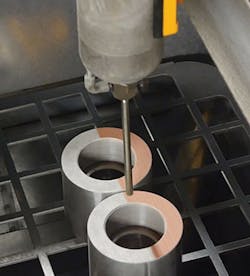EMLACS project explores laser-assisted cold-spray material deposition
With Cold Spray technology, coating lightweight materials such as plastics or carbon fiber-reinforced plastic (CFRP) is significantly simpler. In the EU-funded project "Efficient Manufacturing of Laser-Assisted Cold-Sprayed Components" (EMLACS; www.emlacs.eu), ultrafast laser pulses modify material surfaces so that metal powder from a cold gas jet can adhere more easily. The project unites five partners from industry and research who want to extend low-pressure cold gas spraying to new applications.
Cold Gas Spraying is an additive manufacturing process in which metal powders are accelerated to supersonic speeds to adhere to material surfaces. The material deposition process is based on the kinetic energy of the particles. A thick layer (>0.5mm) is deposited with no thermal defect in the substrate. The deposited layer can be directly machined or reworked.
The main advantages of low-pressure cold gas spraying are the lack of heat input, high processing speed, and low investment cost. New material combinations are especially promising in automotive and aeronautics.
The main challenge in this technology is the adherence of the first layer on the workpiece. The aim of the EU research project EMLACS will improve adhesion on different substrates by using high-speed laser surface structuring with integrated nanosecond and picosecond lasers with low-pressure cold gas spraying. New material combinations can then be developed for industrial use.
The deposition of metallic materials (copper or aluminum; FIGURE) on CFRP and glass fiber-reinforced plastic (GFRP) substrates is being investigated, which has already created significant interest in the aeronautic and automotive industries. In addition, the new technology can be applied in novel ways in electronics manufacturing. As an example, Cold Gas Spraying may deposit a copper layer on a non-conducting housing for fanless heat removal from electronic components.
The project team is composed of French, Dutch, and German partners. Dycomet Europe (Netherlands) brings cold gas spraying expertise, Edgewave (Germany) delivers high-power short-pulsed laser technology, and Industrial Laser Systems (France) is acting as the system integrator and coordinator of the project. Research teams from Université de Technologie de Belfort-Montbéliard (UTBM; France) and the Fraunhofer Institute for Laser Technology (ILT; Germany) are developing the process.
The EMLACS project (reference number 606567) has been running since June 2014 under Research for SMEs – FP7-SME-2013 and has been funded by the Research Executive Agency (REA) for 24 months.
This article was written by Gail Overton, senior editor for Laser Focus World.

